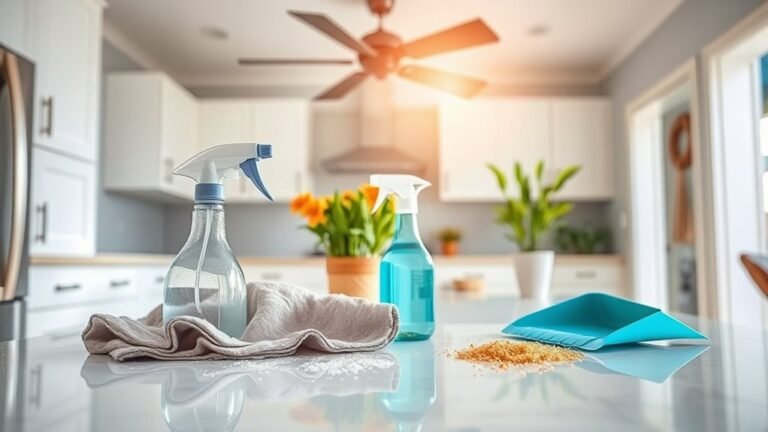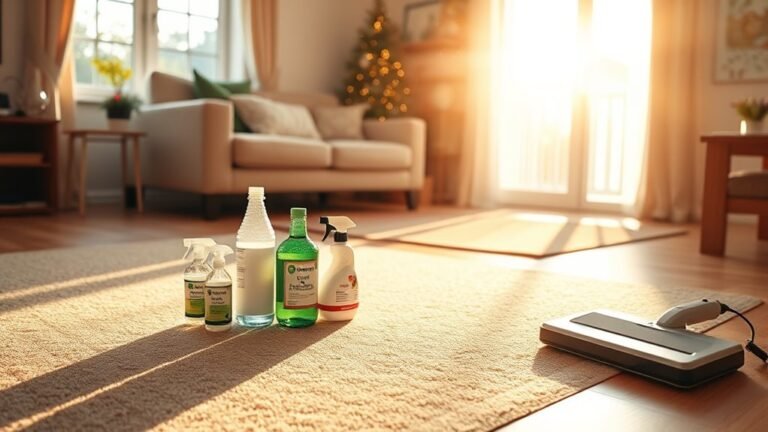How Much Psi to Clean Concrete
To clean concrete effectively, you should use pressure settings of 2,500 to 3,000 psi for standard concrete. If you’re dealing with softer surfaces like stamped concrete, reduce the pressure to 1,500 to 2,000 psi to prevent damage. Make sure to assess the surface beforehand and adjust your cleaning technique as needed. For a more thorough understanding of the cleaning process and maintenance tips, there’s more to explore on this topic.
##
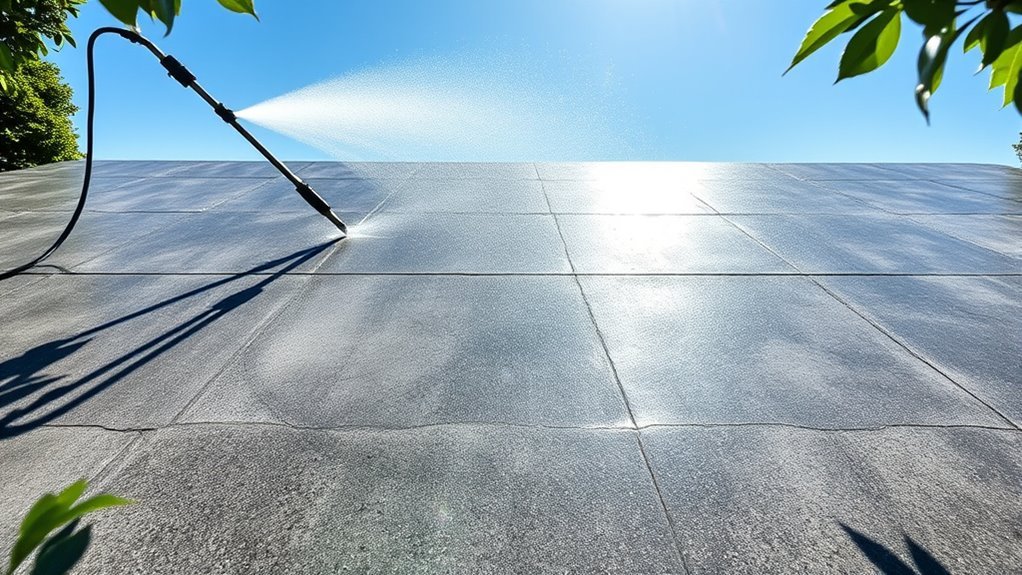
When it comes to cleaning concrete, understanding the right pressure settings is essential for achieving optimal results. This article will guide you through the necessary psi (pounds per square inch) levels to effectively remove dirt, grime, and tougher stains without damaging the surface. Whether you’re dealing with typical messes or stubborn oil and grease stains, you’ll find valuable insights on the appropriate pressure ranges, along with tips on assessing the condition of your concrete. By the end of this article, you’ll be equipped with the knowledge needed to clean your concrete surfaces efficiently and safely, ensuring they look their best.
Preparation For Cleaning
Before you start cleaning your concrete surfaces, it’s crucial to prepare adequately to guarantee effective results. Begin with a thorough surface assessment; check for cracks, stains, or any damage that may need addressing. This evaluation will help you determine the appropriate cleaning method and psi level required. Next, establish a cleaning schedule that aligns with the specific needs of your concrete. Consider factors like weather conditions and the level of dirt or grime buildup. Planning your cleaning sessions guarantees you’re not only efficient but also prolongs the life of your concrete surfaces. By following these preparatory steps, you’ll set yourself up for success, assuring your cleaning efforts yield the best possible outcome.
Tools and Chemical Required
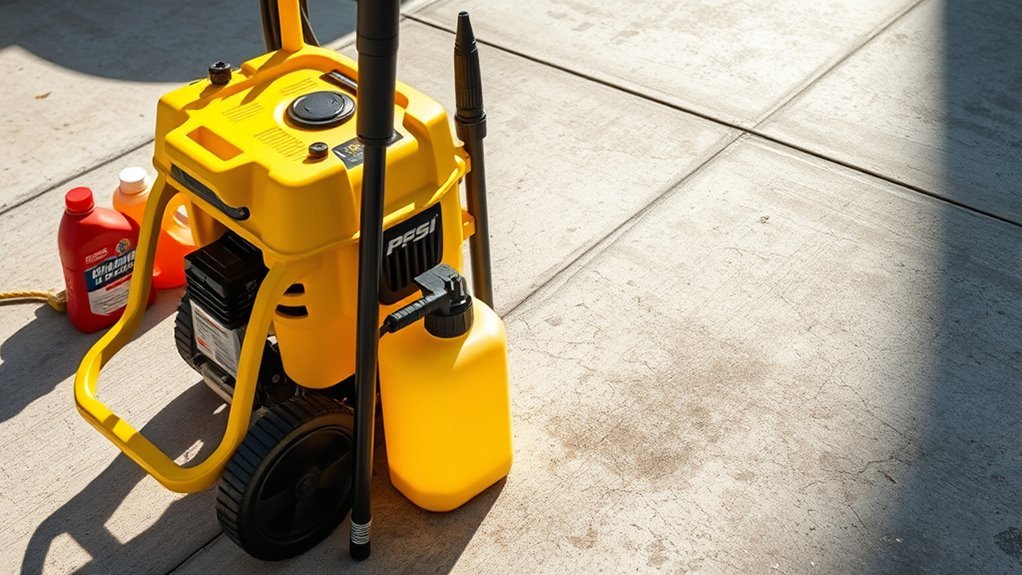
To achieve ideal cleaning results for your concrete surfaces, you’ll need specific tools and chemicals tailored to the task. A high-quality pressure washer is crucial, as it delivers the necessary psi for effective cleaning. Additionally, selecting the right cleaning solutions will enhance your results by breaking down stubborn stains and grime.
| Tool/Chemical | Purpose |
|---|---|
| Pressure Washer | Provides high-pressure spray |
| Concrete Cleaner | Removes tough stains |
| Degreaser | Tackles oil and grease |
| Surface Cleaner | General cleaning |
| Safety Gear | Protects from chemical exposure |
Regular cleaning and proper preparation prevent unexpected breakdowns and extend the life of your equipment by maintaining optimal performance.
How to Clean:
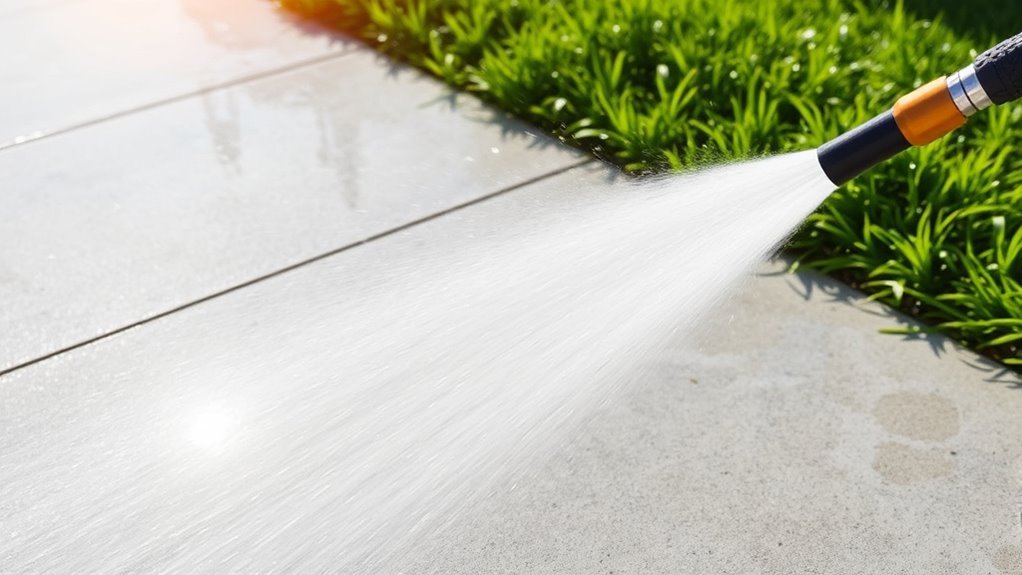
Step 1: Gather Your Tools and Chemicals
- Assemble the necessary cleaning equipment, including a pressure washer, appropriate nozzles, and a chemical cleaner suited for concrete.
- Ensure you have protective gear, such as gloves and goggles, to safeguard against chemicals and high pressure.
Step 2: Identify the Type of Concrete
- Determine the type of concrete surface you will be cleaning, as this influences the pressure settings needed.
- For standard concrete, aim for a pressure setting between 2,500 to 3,000 psi.
- For softer surfaces like stamped concrete, adjust the pressure to a lower setting of 1,500 to 2,000 psi to avoid any damage.
Step 3: Apply Chemical Cleaner
- Select a chemical cleaner that is effective for concrete surfaces and follow the manufacturer’s instructions for dilution, if necessary.
- Evenly apply the cleaner across the concrete surface using a sprayer or roller.
- Allow the cleaner to dwell on the surface for the recommended time, enabling it to penetrate and break down grime effectively.
Step 4: Begin Pressure Washing
- Once the cleaner has had sufficient time to work, prepare your pressure washer for operation.
- Start at one end of the concrete surface and work your way systematically to the other end to ensure thorough cleaning.
- Use smooth, sweeping motions with the pressure washer to lift away dirt and debris.
Step 5: Rinse Thoroughly
- After cleaning the entire surface, switch to a rinsing nozzle on your pressure washer.
- Rinse the concrete thoroughly to remove any remaining chemical residue and loosened dirt.
- Ensure that no spots are missed, as residue can lead to discoloration or stains.
Step 6: Inspect the Surface
- After rinsing, take a moment to inspect the concrete for any areas that may require additional cleaning.
- If necessary, repeat the cleaning process on any stubborn spots that still appear dirty or stained.
Step 7: Allow to Dry
- Allow the cleaned concrete surface to dry completely before using it or applying any sealants.
- Check the weather forecast to avoid cleaning on days with rain or high humidity, as this can affect the drying process.
Step 8: Maintain Regular Cleaning
- To keep your concrete looking its best, establish a regular cleaning schedule based on typical wear and tear.
- Consider applying a protective sealant to enhance durability and ease future cleaning efforts.
- Using natural cleaning options such as vinegar and baking soda can be effective and environmentally friendly alternatives to harsh chemical cleaners.
Safety Consideration

While cleaning concrete can be straightforward, it’s crucial to prioritize safety throughout the process. Using the right pressure settings and guaranteeing surface protection can help prevent accidents and damage.
Prioritizing safety is essential when cleaning concrete to prevent accidents and ensure surface protection.
- Always wear appropriate personal protective equipment, like gloves and goggles.
- Test pressure settings on a small, inconspicuous area to avoid damaging your concrete.
- Make certain the work area is clear of obstacles and bystanders to minimize risks.
Tips to keep clean for long time
Maintaining clean concrete surfaces requires consistent care and attention, especially since neglect can lead to stubborn stains and deterioration over time. To guarantee longevity, start with regular maintenance, including sweeping and rinsing to remove debris. Use a pH-neutral cleaner for deeper cleaning, avoiding harsh chemicals that can damage the surface. For stain prevention, promptly address spills with absorbent materials and seal your concrete every few years to create a protective barrier. Consider installing mats or rugs in high-traffic areas to minimize wear. Finally, keep an eye on your concrete’s condition; early intervention can save you from costly repairs later. By following these maintenance tips, you’ll enjoy clean, attractive concrete for years to come. Additionally, applying a grout sealant can protect grout lines from stains and moisture, enhancing the overall durability of your concrete surfaces.
Frequently Asked Questions
Can I Use a Lower PSI for Delicate Concrete Surfaces?
Yes, you can use a lower psi for delicate concrete surfaces. While high-pressure cleaning techniques may effectively remove tough stains, they can also damage softer surface materials. By opting for a lower psi, you’ll minimize the risk of etching or chipping, ensuring the integrity of your concrete remains intact. Always test a small area first to find the ideal balance between effective cleaning and preserving the surface’s quality.
How Often Should I Clean My Concrete Surfaces?
You should clean your concrete surfaces at least once or twice a year, depending on the traffic and exposure to elements. For high-traffic areas, consider quarterly cleanings to maintain ideal surface integrity. Regular cleaning frequency helps prevent staining and degradation, ensuring better surface maintenance. Additionally, seasonal cleanings can remove debris and prevent mold growth, extending the life of your concrete. Keep your surfaces looking great and performing well by sticking to a consistent cleaning schedule.
Will High PSI Damage My Existing Concrete Sealant?
Yes, a high psi can damage your existing concrete sealant. Think about it: if your sealant can’t withstand the pressure limits, it’s bound to break down. Different sealant types have varying tolerances, so you need to know what you’re working with. Generally, sticking to a lower psi—usually below 3000 psi—is safer for preserving your sealant. Always check the manufacturer’s specifications to avoid costly repairs and guarantee your surface stays protected.
What Is the Best Time of Year to Clean Concrete?
The best time of year to clean concrete is during spring cleaning. This season’s mild temperatures and lower humidity create ideal conditions for effective cleaning and drying. Spring also allows you to inspect for damage as part of your seasonal maintenance routine. You’ll want to avoid extreme heat or cold, which can affect cleaning results. By tackling your concrete in spring, you guarantee a thorough and efficient cleaning process, keeping your surfaces in top shape.
Can I Use My Pressure Washer for Other Surfaces?
Absolutely, you can use your pressure washer for other surfaces! Think of it as a versatile tool in your cleaning arsenal. It’s great for deck cleaning, where it revitalizes wood and removes dirt. For patio maintenance, it effortlessly tackles grime and stains, making your outdoor space shine. Just make sure to adjust the pressure settings to suit different materials—too much pressure can damage softer surfaces like wood or composite decking. Enjoy the freedom of a clean space!


